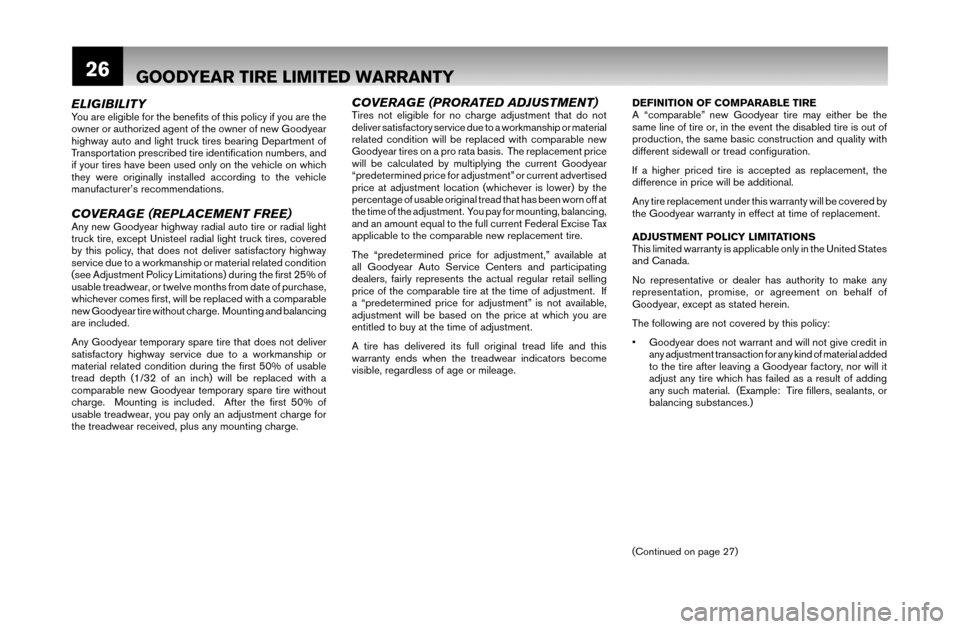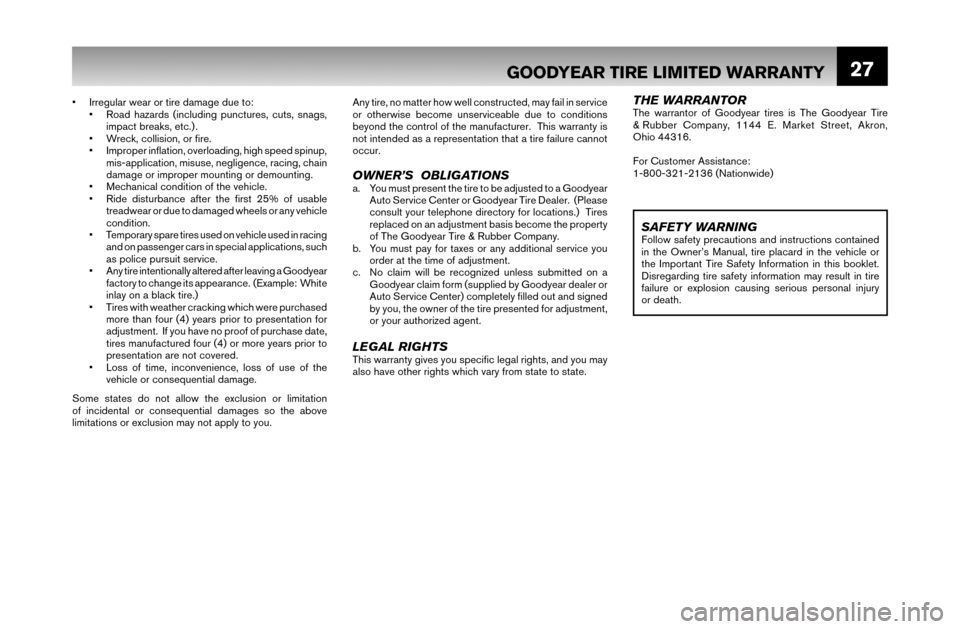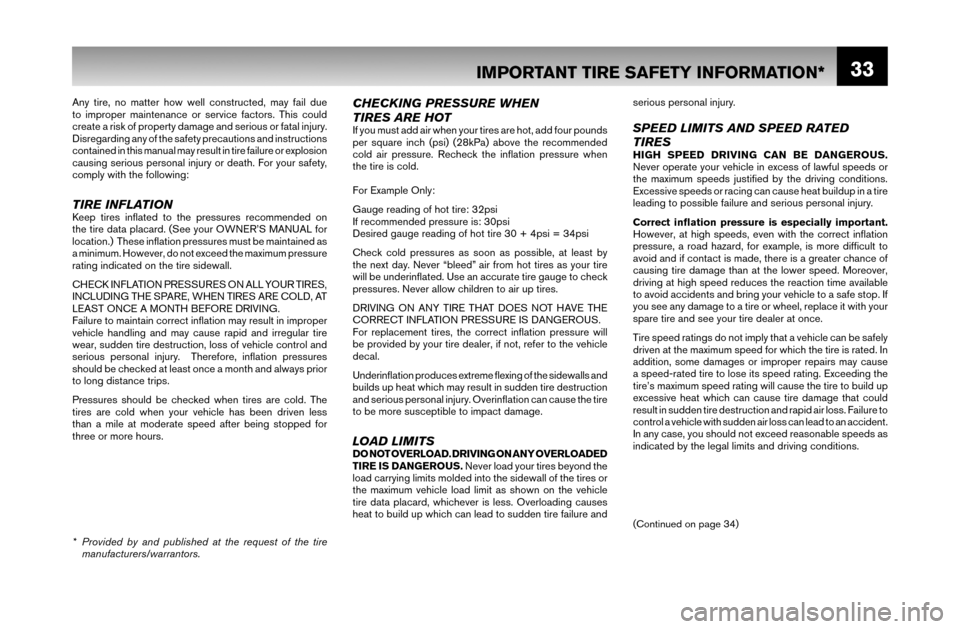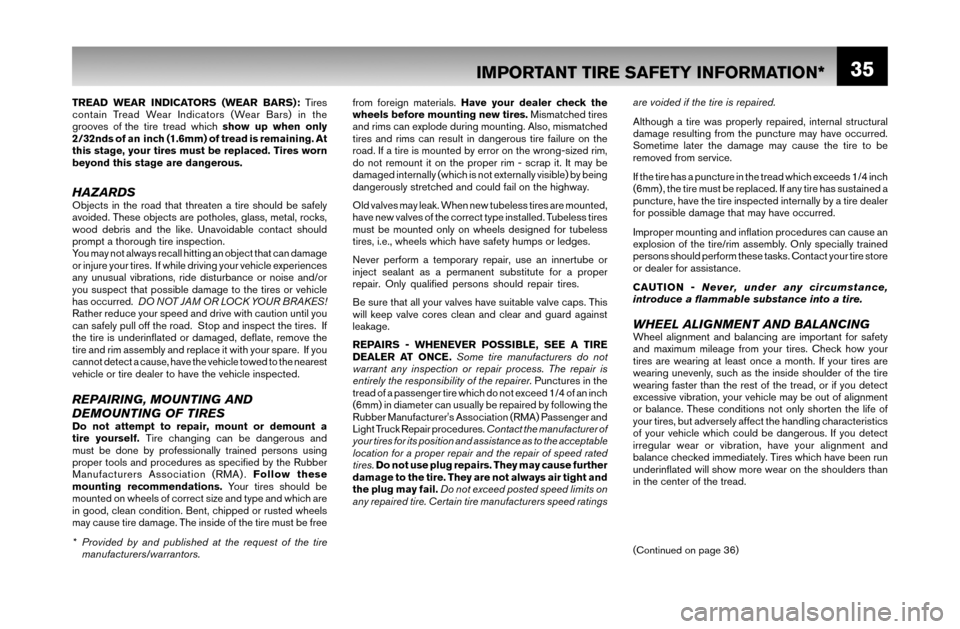2007 NISSAN MURANO spare tire location
[x] Cancel search: spare tire locationPage 29 of 55

26
ELIGIBILITYYou are eligible for the benefi ts of this policy if you are the
owner or authorized agent of the owner of new Goodyear
highway auto and light truck tires bearing Department of
Transportation prescribed tire identifi cation numbers, and
if your tires have been used only on the vehicle on which
they were originally installed according to the vehicle
manufacturer’s recommendations.
COVERAGE (REPLACEMENT FREE)Any new Goodyear highway radial auto tire or radial light
truck tire, except Unisteel radial light truck tires, covered
by this policy, that does not deliver satisfactory highway
service due to a workmanship or material related condition
(see Adjustment Policy Limitations) during the fi rst 25% of
usable treadwear, or twelve months from date of purchase,
whichever comes fi rst, will be replaced with a comparable
new Goodyear tire without charge. Mounting and balancing
are included.
Any Goodyear temporary spare tire that does not deliver
satisfactory highway service due to a workmanship or
material related condition during the fi rst 50% of usable
tread depth (1/32 of an inch) will be replaced with a
comparable new Goodyear temporary spare tire without
charge. Mounting is included. After the fi rst 50% of
usable treadwear, you pay only an adjustment charge for
the treadwear received, plus any mounting charge.
COVERAGE (PRORATED ADJUSTMENT)Tires not eligible for no charge adjustment that do not
deliver satisfactory service due to a workmanship or material
related condition will be replaced with comparable new
Goodyear tires on a pro rata basis. The replacement price
will be calculated by multiplying the current Goodyear
“predetermined price for adjustment” or current advertised
price at adjustment location (whichever is lower) by the
percentage of usable original tread that has been worn off at
the time of the adjustment. You pay for mounting, balancing,
and an amount equal to the full current Federal Excise Tax
applicable to the comparable new replacement tire.
The “predetermined price for adjustment,” available at
all Goodyear Auto Service Centers and participating
dealers, fairly represents the actual regular retail selling
price of the comparable tire at the time of adjustment. If
a “predetermined price for adjustment” is not available,
adjustment will be based on the price at which you are
entitled to buy at the time of adjustment.
A tire has delivered its full original tread life and this
warranty ends when the treadwear indicators become
visible, regardless of age or mileage.DEFINITION OF COMPARABLE TIRE
A “comparable” new Goodyear tire may either be the
same line of tire or, in the event the disabled tire is out of
production, the same basic construction and quality with
different sidewall or tread confi guration.
If a higher priced tire is accepted as replacement, the
difference in price will be additional.
Any tire replacement under this warranty will be covered by
the Goodyear warranty in effect at time of replacement.
ADJUSTMENT POLICY LIMITATIONS
This limited warranty is applicable only in the United States
and Canada.
No representative or dealer has authority to make any
representation, promise, or agreement on behalf of
Goodyear, except as stated herein.
The following are not covered by this policy:
• Goodyear does not warrant and will not give credit in
any adjustment transaction for any kind of material added
to the tire after leaving a Goodyear factory, nor will it
adjust any tire which has failed as a result of adding
any such material. (Example: Tire fi llers, sealants, or
balancing substances.)
GOODYEAR TIRE LIMITED WARRANTY
(Continued on page 27)
57052 Booklet text pages.indd 2657052 Booklet text pages.indd 268/30/06 3:34:22 PM8/30/06 3:34:22 PM
Page 30 of 55

27
• Irregular wear or tire damage due to:
• Road hazards (including punctures, cuts, snags,
impact breaks, etc.) .
• Wreck, collision, or fi re.
• Improper infl ation, overloading, high speed spinup,
mis-application, misuse, negligence, racing, chain
damage or improper mounting or demounting.
• Mechanical condition of the vehicle.
• Ride disturbance after the fi rst 25% of usable
treadwear or due to damaged wheels or any vehicle
condition.
• Temporary spare tires used on vehicle used in racing
and on passenger cars in special applications, such
as police pursuit service.
• Any tire intentionally altered after leaving a Goodyear
factory to change its appearance. (Example: White
inlay on a black tire.)
• Tires with weather cracking which were purchased
more than four (4) years prior to presentation for
adjustment. If you have no proof of purchase date,
tires manufactured four (4) or more years prior to
presentation are not covered.
• Loss of time, inconvenience, loss of use of the
vehicle or consequential damage.
Some states do not allow the exclusion or limitation
of incidental or consequential damages so the above
limitations or exclusion may not apply to you.THE WARRANTORThe warrantor of Goodyear tires is The Goodyear Tire
& Rubber Company, 1144 E. Market Street, Akron,
Ohio 44316.
For Customer Assistance:
1-800-321-2136 (Nationwide)
SAFETY WARNINGFollow safety precautions and instructions contained
in the Owner’s Manual, tire placard in the vehicle or
the Important Tire Safety Information in this booklet.
Disregarding tire safety information may result in tire
failure or explosion causing serious personal injury
or death. Any tire, no matter how well constructed, may fail in service
or otherwise become unserviceable due to conditions
beyond the control of the manufacturer. This warranty is
not intended as a representation that a tire failure cannot
occur.
OWNER’S OBLIGATIONSa. You must present the tire to be adjusted to a Goodyear
Auto Service Center or Goodyear Tire Dealer. (Please
consult your telephone directory for locations.) Tires
replaced on an adjustment basis become the property
of The Goodyear Tire & Rubber Company.
b. You must pay for taxes or any additional service you
order at the time of adjustment.
c. No claim will be recognized unless submitted on a
Goodyear claim form (supplied by Goodyear dealer or
Auto Service Center) completely fi lled out and signed
by you, the owner of the tire presented for adjustment,
or your authorized agent.
LEGAL RIGHTSThis warranty gives you specifi c legal rights, and you may
also have other rights which vary from state to state.
GOODYEAR TIRE LIMITED WARRANTY
57052 Booklet text pages.indd 2757052 Booklet text pages.indd 278/30/06 3:34:22 PM8/30/06 3:34:22 PM
Page 36 of 55

33
Any tire, no matter how well constructed, may fail due
to improper maintenance or service factors. This could
create a risk of property damage and serious or fatal injury.
Disregarding any of the safety precautions and instructions
contained in this manual may result in tire failure or explosion
causing serious personal injury or death. For your safety,
comply with the following:
TIRE INFLATIONKeep tires infl ated to the pressures recommended on
the tire data placard. (See your OWNER’S MANUAL for
location.) These infl ation pressures must be maintained as
a minimum. However, do not exceed the maximum pressure
rating indicated on the tire sidewall.
CHECK INFLATION PRESSURES ON ALL YOUR TIRES,
INCLUDING THE SPARE, WHEN TIRES ARE COLD, AT
LEAST ONCE A MONTH BEFORE DRIVING.
Failure to maintain correct infl ation may result in improper
vehicle handling and may cause rapid and irregular tire
wear, sudden tire destruction, loss of vehicle control and
serious personal injury. Therefore, infl ation pressures
should be checked at least once a month and always prior
to long distance trips.
Pressures should be checked when tires are cold. The
tires are cold when your vehicle has been driven less
than a mile at moderate speed after being stopped for
three or more hours.
CHECKING PRESSURE WHEN
TIRES ARE HOT
If you must add air when your tires are hot, add four pounds
per square inch (psi) (28kPa) above the recommended
cold air pressure. Recheck the infl ation pressure when
the tire is cold.
For Example Only:
Gauge reading of hot tire: 32psi
If recommended pressure is: 30psi
Desired gauge reading of hot tire 30 + 4psi = 34psi
Check cold pressures as soon as possible, at least by
the next day. Never “bleed” air from hot tires as your tire
will be underinfl ated. Use an accurate tire gauge to check
pressures. Never allow children to air up tires.
DRIVING ON ANY TIRE THAT DOES NOT HAVE THE
CORRECT INFLATION PRESSURE IS DANGEROUS.
For replacement tires, the correct infl ation pressure will
be provided by your tire dealer, if not, refer to the vehicle
decal.
Underinfl ation produces extreme fl exing of the sidewalls and
builds up heat which may result in sudden tire destruction
and serious personal injury. Overinfl ation can cause the tire
to be more susceptible to impact damage.
LOAD LIMITSDO NOT OVERLOAD. DRIVING ON ANY OVERLOADED
TIRE IS DANGEROUS. Never load your tires beyond the
load carrying limits molded into the sidewall of the tires or
the maximum vehicle load limit as shown on the vehicle
tire data placard, whichever is less. Overloading causes
heat to build up which can lead to sudden tire failure and serious personal injury.
SPEED LIMITS AND SPEED RATED
TIRES
HIGH SPEED DRIVING CAN BE DANGEROUS.
Never operate your vehicle in excess of lawful speeds or
the maximum speeds justifi ed by the driving conditions.
Excessive speeds or racing can cause heat buildup in a tire
leading to possible failure and serious personal injury.
Correct infl ation pressure is especially important.
However, at high speeds, even with the correct infl ation
pressure, a road hazard, for example, is more diffi cult to
avoid and if contact is made, there is a greater chance of
causing tire damage than at the lower speed. Moreover,
driving at high speed reduces the reaction time available
to avoid accidents and bring your vehicle to a safe stop. If
you see any damage to a tire or wheel, replace it with your
spare tire and see your tire dealer at once.
Tire speed ratings do not imply that a vehicle can be safely
driven at the maximum speed for which the tire is rated. In
addition, some damages or improper repairs may cause
a speed-rated tire to lose its speed rating. Exceeding the
tire’s maximum speed rating will cause the tire to build up
excessive heat which can cause tire damage that could
result in sudden tire destruction and rapid air loss. Failure to
control a vehicle with sudden air loss can lead to an accident.
In any case, you should not exceed reasonable speeds as
indicated by the legal limits and driving conditions.
* Provided by and published at the request of the tire
manufacturers/warrantors.
IMPORTANT TIRE SAFETY INFORMATION*
(Continued on page 34)
57052 Booklet text pages.indd 3357052 Booklet text pages.indd 338/30/06 3:34:25 PM8/30/06 3:34:25 PM
Page 38 of 55

35
TREAD WEAR INDICATORS (WEAR BARS): Tires
contain Tread Wear Indicators (Wear Bars) in the
grooves of the tire tread which show up when only
2/32nds of an inch (1.6mm) of tread is remaining. At
this stage, your tires must be replaced. Tires worn
beyond this stage are dangerous.
HAZARDSObjects in the road that threaten a tire should be safely
avoided. These objects are potholes, glass, metal, rocks,
wood debris and the like. Unavoidable contact should
prompt a thorough tire inspection.
You may not always recall hitting an object that can damage
or injure your tires. If while driving your vehicle experiences
any unusual vibrations, ride disturbance or noise and/or
you suspect that possible damage to the tires or vehicle
has occurred. DO NOT JAM OR LOCK YOUR BRAKES!
Rather reduce your speed and drive with caution until you
can safely pull off the road. Stop and inspect the tires. If
the tire is underinfl ated or damaged, defl ate, remove the
tire and rim assembly and replace it with your spare. If you
cannot detect a cause, have the vehicle towed to the nearest
vehicle or tire dealer to have the vehicle inspected.
REPAIRING, MOUNTING AND
DEMOUNTING OF TIRES
Do not attempt to repair, mount or demount a
tire yourself. Tire changing can be dangerous and
must be done by professionally trained persons using
proper tools and procedures as specifi ed by the Rubber
Manufacturers Association (RMA) . Follow these
mounting recommendations. Your tires should be
mounted on wheels of correct size and type and which are
in good, clean condition. Bent, chipped or rusted wheels
may cause tire damage. The inside of the tire must be free from foreign materials. Have your dealer check the
wheels before mounting new tires. Mismatched tires
and rims can explode during mounting. Also, mismatched
tires and rims can result in dangerous tire failure on the
road. If a tire is mounted by error on the wrong-sized rim,
do not remount it on the proper rim - scrap it. It may be
damaged internally (which is not externally visible) by being
dangerously stretched and could fail on the highway.
Old valves may leak. When new tubeless tires are mounted,
have new valves of the correct type installed. Tubeless tires
must be mounted only on wheels designed for tubeless
tires, i.e., wheels which have safety humps or ledges.
Never perform a temporary repair, use an innertube or
inject sealant as a permanent substitute for a proper
repair. Only qualifi ed persons should repair tires.
Be sure that all your valves have suitable valve caps. This
will keep valve cores clean and clear and guard against
leakage.
REPAIRS - WHENEVER POSSIBLE, SEE A TIRE
DEALER AT ONCE. Some tire manufacturers do not
warrant any inspection or repair process. The repair is
entirely the responsibility of the repairer. Punctures in the
tread of a passenger tire which do not exceed 1/4 of an inch
(6mm) in diameter can usually be repaired by following the
Rubber Manufacturer's Association (RMA) Passenger and
Light Truck Repair procedures. Contact the manufacturer of
your tires for its position and assistance as to the acceptable
location for a proper repair and the repair of speed rated
tires. Do not use plug repairs. They may cause further
damage to the tire. They are not always air tight and
the plug may fail. Do not exceed posted speed limits on
any repaired tire. Certain tire manufacturers speed ratings are voided if the tire is repaired.
Although a tire was properly repaired, internal structural
damage resulting from the puncture may have occurred.
Sometime later the damage may cause the tire to be
removed from service.
If the tire has a puncture in the tread which exceeds 1/4 inch
(6mm) , the tire must be replaced. If any tire has sustained a
puncture, have the tire inspected internally by a tire dealer
for possible damage that may have occurred.
Improper mounting and infl ation procedures can cause an
explosion of the tire/rim assembly. Only specially trained
persons should perform these tasks. Contact your tire store
or dealer for assistance.
CAUTION - Never, under any circumstance,
introduce a fl ammable substance into a tire.
WHEEL ALIGNMENT AND BALANCINGWheel alignment and balancing are important for safety
and maximum mileage from your tires. Check how your
tires are wearing at least once a month. If your tires are
wearing unevenly, such as the inside shoulder of the tire
wearing faster than the rest of the tread, or if you detect
excessive vibration, your vehicle may be out of alignment
or balance. These conditions not only shorten the life of
your tires, but adversely affect the handling characteristics
of your vehicle which could be dangerous. If you detect
irregular wear or vibration, have your alignment and
balance checked immediately. Tires which have been run
underinfl ated will show more wear on the shoulders than
in the center of the tread.
* Provided by and published at the request of the tire
manufacturers/warrantors.
IMPORTANT TIRE SAFETY INFORMATION*
(Continued on page 36)
57052 Booklet text pages.indd 3557052 Booklet text pages.indd 358/30/06 3:34:27 PM8/30/06 3:34:27 PM